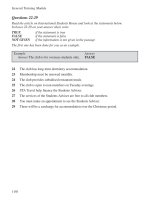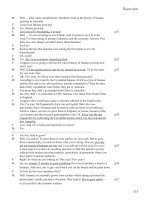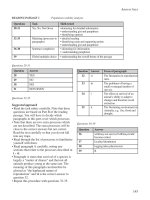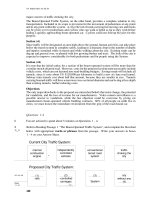Cambridge Practice Tests for IELTS part 10
Bạn đang xem bản rút gọn của tài liệu. Xem và tải ngay bản đầy đủ của tài liệu tại đây (130.82 KB, 15 trang )
130
Answer keys
PRACTICE TEST 1
LISTENING
Section 1
1 A
2 C
3 D
4 D
5 C
6 Prescott (must be correct spelling
with capital “P”)
7 41
8 Fountain (must have capital “F”)
9 752239
10 £65
Section 2
11 E
12 F
13 H
14 $250 million
15 roads//road system
16 too late
17 school children//boys
18 3
19 boats//pleasure crafty/boats and
pleasure craft
20 pilot
21 (musical) instruments
Section 3
22 A
23 B
24 C
25 A
26 talk//give a talk
27 write up work
28 can choose
29 open book
30 closed reserve
31 vocational (subjects)//(preparing for)
work/employment
Section 4
32 B
33 C
34 history and economics
35 (meeting) deadlines (for essays)
36 attendance
37 B
38 C
39 B
40 D
41 A
in
any
order
131
Answer keys
PRACTICE TEST 1
READING
READING PASSAGE 1 A spark, a flint: How fire leapt to life
Questions 1-8
Questions 9-15
Suggested approach
• Read the task rubric carefully. In this task you
have to decide which match is being described
in each question.
• Decide what information is best to skim for in
the passage: the type of match or the
description. In this question it is best to skim
for the types of match as these are names, some
of which are in italics, they are easier for you to
pick out.
• Skim through the text until you find match A,
the Ethereal Match.
• Read that section of the text and underline any
important features of this match.
• Read through the descriptions and write A next
to any that fit this type of match.
If you think there is more than one possible
description for the match, note A next to both.
(The rubric states that you may use any match
more than once. )
• Towards the top of the second page of the text
it states that the Ethereal Match consisted of a
“sealed glass tube”, so A is the answer to
question 14. Note that the description is
expressed differently from the text. Sometimes
you have to match the meaning rather than the
words.
• If you think none of the descriptions fits this
type of match, go on to the next the rubric also
states that there are not enough descriptions to
fit all the matches.
Questions Task Skills tested
1-8 Gap fill summary • skimming for information
• detailed understanding of a section of text
• ability to paraphrase/re-word original text
9-15 Matching (items to
descriptions)
• skimming for specific information
• understanding description/characteristics
• understanding paraphrase
Question Answer
1 preserve
2 unaware
3 chance
4 friction
5 rotating
6 percussion
7 Eskimos
8 despite
Question Answer
9
10
11
F
D
E
14 A “… a sealed glass tube …”
12 C “The first matches resembling
those used today …”
13 G “… a brewery had the novel
idea of advertising …”
Location of answer in text
“… the red phosphorus was
non toxic”
“… three years later it was
copied …”
“… since white phosphorus is
a deadly poison …”
15 C “… borrowed the formula
from a military rocket-
maker …”
132
Question Answer Location of answer in text
26 A “… 10,000 is a serious
underestimate of the total
number of places
masquerading as zoological
establishments.”
27 D “One would assume that the
calibre of these institutions
would have been carefully
examined but …”
28 E The last two paragraphs of the
text but in particular: “Today
approximately 16 species
might be said to have been
“saved” by captive breeding
programmes, although a
number of these can hardly be
looked upon as resounding
successes.”
Practice Test 1
READING PASSAGE 2 Zoo conservation programmes
Questions 16-25
Questions 26-28
Suggested approach
• Read the task rubric carefully. Only three of the
factors in the list are correct. The correct
factors explain why the author doubts the value
of the WZCS document.
• Scan the text and mark the section that
discusses the accuracy/value of theWZCS
document. This is from the third paragraph
onwards.
• Read through the list of factors to familiarise
yourself with it.
• Begin reading the third paragraph more
carefully, looking for phrases that signal that
the writer is going to discuss something that is
wrong with the document. The first signal is:
'This is probably the document's first failing …'
You can infer from what the writer
then states, that A is one of the correct factors.
• Re-read the list of factors from B-F.
• Continue reading the text, looking for other
signals.
• Select the two other correct factors.
Remember that if you put more than one factor
beside each question number on your answer
sheet, you will not get any marks. However the
three correct answers can be written down in
any order.
in
any
order
Questions Task Skills tested
16-22 Yes, No, Not Given • skimming for detailed information
• identifying attitude and opinion
• understanding gist and paraphrase
23-25 Multiple choice • skimming for factual information
• identifying main and supporting points
• understanding attitude
26-28 Selecting factors • skimming/scanning for specific information
• identifying main ideas
• understanding paraphrase and inference
Answer
YES
YES
NOT GIVEN
NO
NO
NOT GIVEN
YES
B
Question
16
17
18
19
20
21
22
23
C
A
24
25
133
Answer keys
READING PASSAGE 3 Architecture
Questions 29-35
Questions 36-40
Suggested approach
• Read the task rubric carefully. You have to
decide which effect arose from each cause.
• Decide which list you should work from. In
this case it is better to work from List A as you
must find an effect m List B for every question.
The causes also come first chronologically in
the cause/effect relationship: List B contains
results of List A.
• Read through List B to familiarise yourself
with it.
• Read item 36.
• Skim through the passage until you locate the
information in the text.
• Read this section of the text in detail noting any
effects of 36.
• Read through List B again.
• Select the effect of question 36. If you think
there is more than one effect, mark both and
come back to this item later. But remember that
only one answer is correct.
• In the third paragraph it states that the
increase in urban populations “helped to turn
parts of cities into slums”. So the answer to
question 36 is G.
• Repeat this procedure with items 37-40.
Questions Task Skills tested
29-35 Completing a table • following a chronological account
• skimming for specific information
• noting main ideas
36-40 Matching (causes to
effects)
• skimming/scanning for information
• understanding cause and effect relationships
• understanding paraphrase
Answer
timber and stone
Modernism
International style
preservation
High-Tech
Question
29
30
31
33
34
badly designed buildings//multi-storey
housmg//mass-produced, low-cost
high-rises
32
co-existence of styles//different styles
together//styles mixed
35
Question Answer Location of answer in text
39 C “Many of these buildings …
have since been demolished.”
40 D “They originated in the US …
to help meet the demand for
more economical use of land.”
36 G “Such rapid and uncontrolled
growth helped to turn parts of
cities into slums.”
37 F “These were stripped of
unnecessary decoration that
would detract from their
primary purpose — to be used
or lived in.”
38 H “But the economic depression
prevented their ideas from
being widely realised until the
economic conditions
improved …”
134
Practice Test 2
PRACTICE TEST 2
LISTENING KEYS
Section 1
1 student accommodation/hostel
2 awful food
3 not friendly//kept to themselves (do not
accept “lonely”)
4 lecturers (too) busy
5 regular meetings//meetings with
lecturers//fortnightly meetings
6 family//homestay
7 lot of noise//children made noise//difficult
to study
8 student house
9 (Bachelor of) Computing
10 reserve computer time
Section 2
11 mountain
12 quality
13 $2,000
14 short/casual rides
15 town riding//shopping
16 serious touring
17 similar//almost the same
18 better quality (components)
19 buying clothes
20 frame
Section 3
21 B
22 C
23 D
24 B
25 one bunch
26 15 months
27 uphill//on hillsides
28 lots of/plenty of water
29 plastic bags
30 bananas/ones (to) ripen
31 C
32 D
Section 4
33 B
34 D
35 C
36 cooking
37 (regular) daily intake
38 (a) variety
39 the dark//the fridge//a cool place//a dark
place
40 eat in moderation//not too much
41 eat lots//eat most
either
way round
135
Answer keys
READING
READING PASSAGE 1 Right and left-handedness in humans
Questions 1-7
Suggested approach
• Read the task rubric carefully. You have to
match the opinions with the people who express
them in the text.
• Read through the list of opinions to familiarise
yourself with it.
• In this case it is probably best to skim through
the text looking for names as these are easy to
identify. So skim through the text until you
come to the first name: Professor Turner.
• The text states in the first paragraph that
Professor Turner has studied left-handedness. It
goes on to say that he noted a “distinctive
asymmetry” in the human population.
• Skim through the list of opinions again Number
7 states “Asymmetry is a common feature of
the human body”. So the answer to question 7
is E.
• Continue this procedure with the rest of the
text. Note that the opinions in the questions are
expressed differently from the text. This is
known as “paraphrasing”. It means that you
will have to match the meaning rather than the
exact words
Questions 8-12
Questions Task Skills tested
1-7 Matching (people to
opinions)
• skimming/scanning for information
• understanding gist and paraphrase
8-10 Completing a table • skimming for factual information
11-12 Multiple choice • skimming/scanning for information
• identifying main and supporting points
• understanding paraphrase
• making inferences
Question Answer Location of answer in text
1
3
5
B
C
A
“… evolution of speech went
with right-handed preference.”
“… there are more left-handed
males than females.”
3rd and 4th sentences of
paragraph 3
2 D gist of final paragraph
4 B “… if a left handed person is
brain damaged in the left
hemisphere the recovery of
speech is quite often better …”
6 C “… discovered that the left-
right asymmetry exists before
birth.”
7 E “He noted that this distinctive
asymmetry in the human
population is itself systematic.”
Answer
15-20%
40%
6%
D
B
Question
8
9
10
11
12









